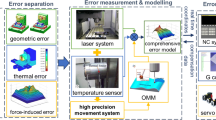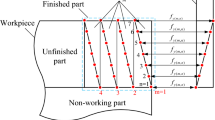Abstract
The thin-walled part is a key component in the aerospace field. However, its low stiffness makes it highly susceptible to deformation during milling. An adaptive compensation method for machining deformation based on state-space control is proposed to aim at the problem of precise wall thickness control of large thin-walled parts. Firstly, based on the state space theory, a closed-loop control model for machining errors of thin-walled parts is established. Taking the overall deformation and the cutter-relieving deformation into consideration comprehensively, a tool position compensation model considering the overall deformation is established, and the structural deformation is compensated based on the dimension correlation. Secondly, the influencing factors of the cutter-relieving deformation are analyzed, and the error model of the deformation during machining is established. The parameters are predicted based on the multi-round on-machine measurement (OMM) data; considering the coupling effect of the compensation value and the cutter-relieving deformation, the compensation value calculation that meets the expected machining wall thickness is realized. Finally, a measurement and processing test is carried out on a certain type of rocket fuel tank to verify the feasibility and effectiveness of the proposed method. The experimental results show that the compensation tool position trajectory based on state-space control can adapt to the deformation state of the actual parts, and the machining accuracy of the fuel tank has been significantly improved.
















Similar content being viewed by others
References
Wang XZ, Bi QZ, Zhu LM, Ding H (2018) Improved forecasting compensatory control to guarantee the remaining wall thickness for pocket milling of a large thin-walled part. Int J Adv Manuf Technol 94(5–8):1677–1688. https://doi.org/10.1007/s00170-016-9785-8
Lv YJ, Peng Z, Qu C, Zhu DH (2020) An adaptive trajectory planning algorithm for robotic belt grinding of blade leading and trailing edges based on material removal profile model. Robot Comput Integr Manuf 66. https://doi.org/10.1016/j.rcim.2022.102398
Li ZL, Tuysuz O, Zhu LM, Altintas Y (2018) Surface form error prediction in five-axis flank milling of thin-walled parts. Int J Mach Tool Manuf 128:21–32. https://doi.org/10.1016/j.ijmachtools.2018.01.005
Wan M, Zhang WH (2009) Systematic study on cutting force modeling methods for peripheral milling. Int J Mach Tool Manuf 49:424–432. https://doi.org/10.1016/j.ijmachtools.2008.12.004
Hou YH, Zhang DH, Zhang Y, Wu BH (2021) The variable radial depth of cut in finishing machining of thin-walled blade based on the stable-state deformation field. Int J Adv Manuf Technol 113(1–2):141–158. https://doi.org/10.1007/s00170-020-06472-7
Zhang Y, Wu T, Li C, Liu JX, Wang YF (2021) Investigation on path optimization and look-ahead speed control algorithm during numerical control grinding of dentures of glass ceramics. Int J Adv Manuf Technol 113(7):1899–1913. https://doi.org/10.1007/s00170-021-06707-1
Sun YW, Jiang SL (2018) Predictive modeling of chatter stability considering force-induced deformation effect in milling thin-walled parts. Int J Mach Tool Manuf 135:38–52. https://doi.org/10.1016/j.ijmachtools.2018.08.003
Zhang PH, Chen YL, Zhang CY, Zha J, Wang T (2018) Influence of geometric errors of guide rails and table on motion errors of hydrostatic guideways under quasi-static condition. Int J Mach Tool Manuf 125:55–67. https://doi.org/10.1016/j.ijmachtools.2017.10.006
Zhang ZL, Qi Y, Cheng Q, Liu ZF, Tao ZQ, Cai LG (2019) Integrated profile and thickness error compensation for curved part based on on-machine measurement. Robot Comput Integr Manuf 59. https://doi.org/10.1016/j.rcim.2019.04.002
Xiong G, Li ZL, Ding Y, Zhu LM (2020) A closed-loop error compensation method for robotic flank milling. Robot Comput Integr Manuf 63. https://doi.org/10.1016/j.rcim.2019.101928
Cheng Q, Zhao HW, Zhao YS, Sun BW, Gu PH (2015) Machining accuracy reliability analysis of multi-axis machine tool based on Monte Carlo simulation. J Intell Manuf 29(1):191–209. https://doi.org/10.1007/s10845-015-1101-1
Liu CQ, Li YG, Shen WM (2018) A real time machining error compensation method based on dynamic features for cutting force induced elastic deformation in flank milling. Mach Sci Technol 22(5):766–786. https://doi.org/10.1080/10910344.2017.1402933
Wang XZ, Li ZL, Bi QZ, Zhu LM, Ding H (2019) An accelerated convergence approach for real-time deformation compensation in large thin-walled parts machining. Int J Mach Tool Manuf 142:98–106. https://doi.org/10.1016/j.ijmachtools.2018.12.004
Yoshioka H, Shinno H, Sawano H, Tanigawa R (2014) Monitoring of distance between diamond tool edge and workpiece surface in ultraprecision cutting using evanescent light. Ann CIRP 63(1):341–344. https://doi.org/10.1016/j.cirp.2014.03.129
Hao XZ, Li YG, Zhao ZW, Liu CQ (2019) Dynamic machining process planning incorporating in process workpiece deformation data for large-size aircraft structural parts. Int J Comput Integr Manuf 32(2):136–147. https://doi.org/10.1080/0951192X.2018.1529431
Zhang SK, Bi QZ, Ji YL, Wang YH (2019) Real-time thickness compensation in mirror milling based on modified Smith predictor and disturbance observer. Int J Mach Tool Manuf 144:1–14. https://doi.org/10.1016/j.ijmachtools.2019.103427
Bi QZ, Huang ND, Zhang SK, Shuai CL, Wang YH (2019) Adaptive machining for curved contour on deformed large skin based on on-machine measurement and isometric mapping. Int J Mach Tool Manuf 136:34–44. https://doi.org/10.1016/j.ijmachtools.2018.09.001
Zeng C, Hu YH, Shi J, Bi QZ (2019) On-machine measurement and compensation of assembling gap for 5-axis friction stir welding based on 2D laser profilometer. IEEE ICMSR 5:70–75. https://doi.org/10.1109/ICMSR.2019.8835456
Wang ZH, Wang SB, Yu L, Wang SL, Zhao ZY, Tang Q (2022) An intelligent process parameters determination method based on multi-algorithms fusion: a case study in five-axis milling. Robot Comput Integr Manuf 73. https://doi.org/10.1016/j.rcim.2021.102244
Lu YAA, Ding Y, Wang CY, Zhu LM (2018) Tool path generation for five-axis machining of blisks with barrel cutters. Int J Prod Res 57(5):1300–1314. https://doi.org/10.1080/00207543.2018.1470344
Bi QZ, Shi J, Wang YH, Zhu LM, Ding H (2015) Analytical curvature-continuous dual-Bézier corner transition for five-axis linear tool path. Int J Mach Tool Manuf 91:96–108. https://doi.org/10.1016/j.ijmachtools.2015.02.002
Huang ND, Bi QZ, Wang YH (2015) Identification of two different geometric error definitions for the rotary axis of the 5-axis machine tools. Int J Mach Tool Manuf 91:109–114. https://doi.org/10.1016/j.ijmachtools.2015.02.003
Huang ND, Bi QZ, Wang YH, Sun C (2014) 5-Axis adaptive flank milling of flexible thin-walled parts based on the on-machine measurement. Int J Mach Tool Manuf 84:1–8. https://doi.org/10.1016/j.ijmachtools.2014.04.004
Choa MW, Kim GH, Seo T, Hong YC, Cheng HH (2006) Integrated machining error compensation method using OMM data and modified PNN algorithm. Int J Mach Tool Manuf 46:1417–1427. https://doi.org/10.1016/j.ijmachtools.2005.10.002
Shi J (2007) Stream of variation modeling and analysis for multistage manufacturing processes. CRC Press, Boca Raton, pp 125–128. https://doi.org/10.1201/9781420003901
Paul RP (1981) Robot manipulators: mathematics, programming and control. The MIT Press, Cambridge
Wang YQ, Liu HB, Jia ZY, Tao Y (2012) Target surface redesign and cutter location calculation based on moving frame theory. Chin J Mech Eng 48(19):141–147. https://doi.org/10.3901/JME.2012.19.141
Acknowledgements
The authors thank the anonymous referees and editors for their valuable comments and suggestions.
Funding
This research was supported by the National Key Research and Development Project (no. 2022YFB3404704), the National Key Research and Development Project (no.2019YFA0709003) and the Changjiang Scholar Program of Chinese Ministry of Education (nos. Q2021053, T2017030).
Author information
Authors and Affiliations
Contributions
Haibo Liu, Qile Bo, and Xu Li contributed the central idea. Xingliang Chai established the theoretical model and wrote the initial draft of the paper. Te Li and Yongqing Wang designed the experiment and analyzed most of the data. Chenglong Wang and JianChi Yu performed the experiment operation.
Corresponding author
Ethics declarations
Ethics approval
This study complies with the ethical standards set out by Springer.
Consent to participate
Not applicable.
Consent for publication
Not applicable.
Competing interests
The authors declare no competing interests.
Additional information
Publisher's note
Springer Nature remains neutral with regard to jurisdictional claims in published maps and institutional affiliations.
Rights and permissions
Springer Nature or its licensor (e.g. a society or other partner) holds exclusive rights to this article under a publishing agreement with the author(s) or other rightsholder(s); author self-archiving of the accepted manuscript version of this article is solely governed by the terms of such publishing agreement and applicable law.
About this article
Cite this article
Liu, H., Chai, X., Yu, J. et al. State-space theory–based closed-loop control of machining error of thin-walled part modeling and application. Int J Adv Manuf Technol 127, 1721–1735 (2023). https://doi.org/10.1007/s00170-023-11542-7
Received:
Accepted:
Published:
Issue Date:
DOI: https://doi.org/10.1007/s00170-023-11542-7




